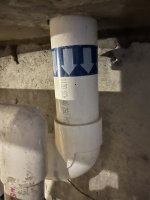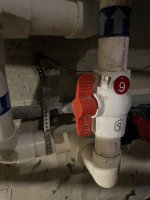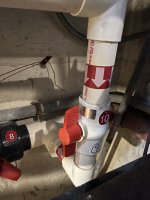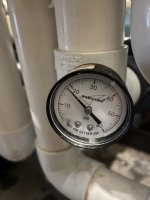Here are some pics that better illustrate the area in the plumbing where (I think) a bypass to the heater is installed.
1st pic... main return line
2nd pic... following the main return line
3rd pic... pipe coming off the return line going to heater with Valve #9 fully open
4th pic... section of the return line between pipe going to heater and pipe returning from heater with Valve #8 partially open
5th pic... pipe coming from the heater back to the return line with Valve #10 fully open
View attachment 648216View attachment 648217View attachment 648218View attachment 648219View attachment 648220
I have seen the pool company adjust Valve #8 in order to maintain a 30 psi reading on the pressure side guage at the pump. I have never seen them adjust Valves 9 or 10. Is this the heater bypass you are referring to? Could playing around with those valves possibly increase the flow? Should I tempoarily shut off flow to the heater (Valve #9) and fully open Valve #8 to see if that affects the flow rate? Any precautions to take when adjusting these valves, i.e., should I turn off the heater first, adjust the valves slowly, which order to make the adjustments, leave Valve #10 open or closed, etc.? Thanks for any guidance on how to tweak these valves to increase flow (without breaking something).

Also, I notice that the suction line from the Main Drain is half closed. Is that common? Is this done in order to increase water flowing through the skimmers?













